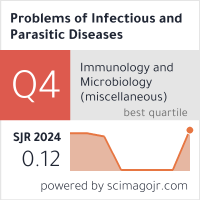MOLECULAR EPIDEMIOLOGICAL ANALYSIS OF THE TRANSMISSION CLUSTERS OF THE HIV-1 CIRCULATING RECOMBINANT FORMS CRF01_AE AND CRF02_ AG IN BULGARIA
DOI:
https://doi.org/10.58395/pipd.v48i1.30Abstract
Background. The purpose of this study was to analyse the underlying HIV transmission clusters of individuals from different vulnerable groups infected with the recombinant forms of HIV-1 – CRF01_AE and CRF02_AG, between 1986 and 2011 using sequencing and phylogenetic analysis.
Material and methods. Blood samples from randomly selected 242 individuals diagnosed with HIV-1 CRF01_AE and CRF02_AG in Bulgaria were analysed. HIV-1 pol gene fragment was sequenced using the ViroSeq HIV-1 Genotyping Test (Abbott) and/or TruGene DNA Sequencing System. The phylogenetic tree reconstruction was performed with the IQ-TREE program. Identification of the phylogenetic clusters was performed using the ClusterPicker program with two parameters to identify recent and distant infection.
Results.Two main local independent epidemics confined to different geographical regions of the country were caused by HIV-1 CRF01_AE and CRF02_AG. The various viral strains circulate predominantly in two major separate regions – CRF01_AE in Sofia and CRF02_AG in Plovdiv. Most of the individuals infected with viral strains analysed in this study were people who inject drugs (PWID) or heterosexuals and only a few were men who have sex with men. The phylogenetic analysis revealed transmission clusters in both recombinant forms, few in number when confined within a short period of time and multiple clusters over an extended timeframe.
Conclusions. The introduction and rapid spread of two different strains of HIV-1 into geographically distant groups of PWID triggered local epidemic outbreaks. The phylogenetic analysis indicated the accelerated transmission of HIV, which is a characteristic of the spread through injection practices. Our study demonstrated that transmission cluster monitoring is important for better understanding of the development of epidemic and could be used as a tool for the identification of risk indicator populations.
Downloads
References
Van Heuverswyn F, Peeters M. The origins of HIV and implications for the global epidemic. Curr Infect Dis Rep. 2007; 338-346.
Sharp PM, Hahn BH. Origins of HIV and the AIDS pandemic. Csh Perspect Med. 2011; 1(1):a006841.
Hemelaar J, Elangovan R, Yun J, Dickson-Tetteh L, Fleminger I, Kirtley S, Williams B, Gouws-Williams E, Ghys PD, Alash’le GA, Agwale S. Global and regional molecular epidemiology of HIV-1, 1990–2015: a systematic review, global survey, and trend analysis. Lancet Infect Dis. 2019; 19(2):143-155.
Alexiev I, Shankar A, Dimitrova R, Gancheva A, Kostadinova A, Teoharov P, Golkocheva E, Nikolova M, Muhtarova M, Elenkov I, Stoycheva M. Origin and spread of HIV-1 in persons who inject drugs in Bulgaria. Infect Genet Evol. 2016; 46:269- 278.
Angelis K, Albert J, Mamais I, Magiorkinis G, Hatzakis A, Hamouda O, Struck D, Vercauteren J, Wensing AM, Alexiev I, Asjö B. Global dispersal pattern of HIV-1 CRF01_AE: a genetic trace of human mobility related to heterosexual activities centralized in South-East Asia. J Infect Dis. 2015; 211(11):1735-1744.
Salemi M, Goodenow MM, Montieri S, de Oliveira T, Santoro MM, Beshkov D, Alexiev I, Elenkov I, Elenkov I, Yakimova T, Varleva T. The HIV type 1 epidemic in Bulgaria involves multiple subtypes and is sustained by continuous viral inflow from West and East European countries. AIDS Res and Hum Retroviruses. 2008; 24(6):771-779.
Alexiev I, Beshkov D, Elenkov I, Stoicheva M, Nikolova D. Molecular Epidemiology Surveillance of Pure HIV-1 Subtypes in Bulgaria. Probl Infect Parasit Dis. 2013; 41(1):19-25.
Alexiev I, Shankar A, Wensing AM, Beshkov D, Elenkov I, Stoycheva M, Nikolova D, Nikolova M, Switzer WM. Low HIV-1 transmitted drug resistance in Bulgaria against a background of high clade diversity. J Antimicrob Chemother. 2015; 70(6):1874-1880.
Alexiev I, Beshkov D, Georgieva V, Varleva T. Diversity of HIV-1 in Bulgaria Phylogenetic analysis. Probl Infect Parasit Dis. 2009; 37(2):9-12.
Ganova-Raeva L, Dimitrova Z, Alexiev I, Punkova L, Sue A, Xia GL, Gancheva A, Dimitrova R, Kostadinova A, Golkocheva- Markova E, Khudyakov Y. HCV transmission in high-risk communities in Bulgaria. PloS one. 2019; 14(3).
Alexiev I, Lo Presti A, Dimitrova R, Foley B, Gancheva A, Kostadinova A, Nikolova L, Angeletti S, Cella E, Elenkov I, Stoycheva M. Origin and spread of HIV-1 subtype B among heterosexual individuals in Bulgaria. AIDS Res Hum Retroviruses. 2018; 34(3):244-253.
Struck D, Lawyer G, Ternes AM, Schmit JC, Bercoff DP. COMET: adaptive context-based modeling for ultrafast HIV-1 subtype identification. Nucleic acids Res. 2014; 42(18):e144.
Peña ACP, Faria NR, Imbrechts S, Libin P, Abecasis AB, Deforche K, Gomez A, Camacho RJ, de Oliveira T, Vandamme A-M. Automated subtyping of HIV-1 genetic sequences for clinical and surveillance purposes: Performance evaluation of the new REGA version 3 and seven other tools. Infect Genet Evol. 2013; 19:337-348.
Larsson A. AliView: a fast and lightweight alignment viewer and editor for large datasets. Bioinformatics. 2014; 30(22):3276-3278.
Robert EC. MUSCLE: multiple sequence alignment with high accuracy and high throughput. Nucleic Acids Res. 2004; 32(5):1792-1797.
Nguyen LT, Schmidt HA, Von Haeseler A, Minh BQ. IQ-TREE: a fast and effective stochastic algorithm for estimating maximum-likelihood phylogenies. Mol Biol Evol. 2015; 32(1):268-274.
Kalyaanamoorthy S, Minh BQ, Wong TK, von Haeseler A, Jermiin LS. ModelFinder: fast model selection for accurate phylogenetic estimates. Nat Methods. 2017; 14(6):587.
Hoang DT, Chernomor O, Von Haeseler A, Minh BQ, Vinh LS. UFBoot2: improving the ultrafast bootstrap approximation. Mol Biol Evol. 2018; 35(2):518-522.
Nikolopoulos GK, Kostaki E-G, Paraskevis D. Overview of HIV molecular epidemiology among people who inject drugs in Europe and Asia. Infect Genet Evol. 2016; 46:256-268.






